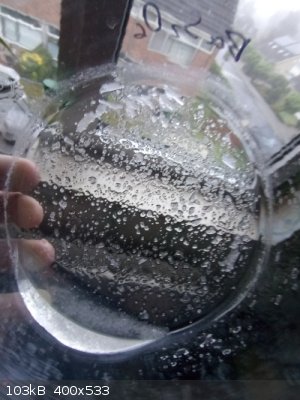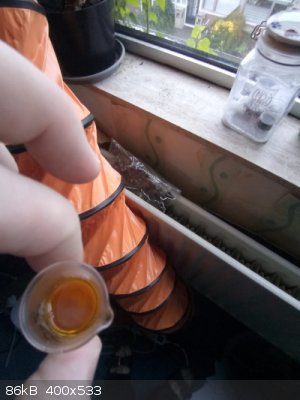Fyndium
International Hazard
    
Posts: 1192
Registered: 12-7-2020
Location: Not in USA
Member Is Offline
|
|
How to recrystallize high solubility substances?
Recrystallizing substances that have lower solubilities like KCl (20g to 60g from 0 to 100 C and so on) is easy, but what if the solubility is high,
like 400 grams per 100mL, and usually the substance is also anhydrous?
What is the proper way to perform this kind of re-crystallization? If the substance is just melted with water, the impurities will also saturate upon
crystallization and evaporation, while they should be decanted or filtered away?
|
|
|
Fery
National Hazard
   
Posts: 990
Registered: 27-8-2019
Location: Czechoslovakia
Member Is Offline
|
|
Do you want to recrystallize only inorganic substances? Sometimes you can use organic solvent. Or at least add it into the solution of the substance
in water so the solubility decreases.
|
|
|
Fyndium
International Hazard
    
Posts: 1192
Registered: 12-7-2020
Location: Not in USA
Member Is Offline
|
|
I think I should look at dual solvent systems for that matter. Many solvents, for example ethanol seems to decrease solubility of many substances very
significantly, but maybe not too much for a working recrystallization to occur.
Are there any good sources or databases of solubilities available, or does one need to just do the google fu thing for every compound there is, or
even try it out in practice? There are some compounds that it is very much impossible to find solubility data.
|
|
|
Sulaiman
International Hazard
    
Posts: 3558
Registered: 8-2-2015
Location: 3rd rock from the sun
Member Is Offline
|
|
Similar but inorganic - silver nitrate is very soluble and prone to supersaturation,
I got nice crystals by leaving a near saturated (at RT) solution in a beaker sealed with a filter paper to evaporate naturally over many days.
The crystals formed so slowly that none of the contaminating copper nitrate crystallised out (judging by the lack of colour)
I also want to learn/practice multi-solvent systems as so far I've only crystallised from aqueous solutions.
CAUTION : Hobby Chemist, not Professional or even Amateur
|
|
|
macckone
International Hazard
    
Posts: 2159
Registered: 1-3-2013
Location: Over a mile high
Member Is Offline
Mood: Electrical
|
|
With dual solvent systems you can't usually use evaporation.
The only time that works is when the solvent that the compound is most soluble in evaporates first or you are using an azetrope or close to azetropic
mix.
Most of the time you are crashing one compound out preferentially.
For example with a urea/ammonium sulfate mix, you can dissolve in water and use various alcohols to crash out the ammonium sulfate while the urea
stays in solution.
This doesn't yield large crystals but it does make them pure.
|
|
|
Fyndium
International Hazard
    
Posts: 1192
Registered: 12-7-2020
Location: Not in USA
Member Is Offline
|
|
I just recrystallized urea from water-ethanol mix just as a test. Initially it required much more ethanol than anticipated, in 1L erlenmeyer for 450g
the total volume was quickly used up and the ethanol was brought to the edge of boil under reflux to prevent vapors. Dropping in water with pipette
increased the solubility to the extent the remaining urea quickly dissolved to form crystal clear solution, and now it's recrystallized to full
extent.
For this matter I see possibilities for dual solvent systems. You can carefully adjust the solubility of substances in order to find a ratio in which
you can use cheap water and more expensive second solvent to have very useful solubility curve.
[Edited on 26-9-2020 by Fyndium]
|
|
|
teodor
National Hazard
   
Posts: 872
Registered: 28-6-2019
Location: Heerenveen
Member Is Offline
|
|
Of course there are methods mentioned in standard preparation or purification instructions for particular components.
But also there is some space for variations depending on time, equipment and the purpose of crystallization. There could be different goals - purity,
constant weight, some specific shape of crystals, exclusion of water for further reactions, getting stable compound version for prolonged storage etc
etc.
I can share my latest experience with 3 compounds:
1. BaS2O6 - slow evaporation in a closed cabinet (sometimes I can wait but have no time to perform any manipulations - in this case I can use this
method). But this method apparently has an advantage for Barium Dithionate - BaCO3 is crystallized separately on walls.

2. FeCl3 powder - metathesis of Fe(NO3)3 with ZnCl2 (both are even more soluble).

3. CoCl2 * 2H2O - dissolving of wet CoCl2 * 6H2O in tert-butyl alcohol and distilling-off the water-alcohol azeotropic mixture (the photo was posted
in the cobalt salts preparation thread).
[Edited on 28-9-2020 by teodor]
[Edited on 28-9-2020 by teodor]
[Edited on 28-9-2020 by teodor]
|
|
|
Fyndium
International Hazard
    
Posts: 1192
Registered: 12-7-2020
Location: Not in USA
Member Is Offline
|
|
I also presume that crashing out works both ways - a substance that dissolves in water, can be crashed out by mixing in a solvent that it is insoluble
but that is miscible with water, like acetone?
|
|
|
teodor
National Hazard
   
Posts: 872
Registered: 28-6-2019
Location: Heerenveen
Member Is Offline
|
|
Also a common ion effect can be widely used for many ionic compounds.
On the other hand, there compounds like CoCl2, FeCl3 etc which require some unique techniques, so I doubt there is a single answer to so generic
question.
More examples: CrO3, Fe(NO3)3. Do you know the good method to recrystallise the last one by the way?
[Edited on 22-10-2020 by teodor]
|
|
|
DraconicAcid
International Hazard
    
Posts: 4278
Registered: 1-2-2013
Location: The tiniest college campus ever....
Member Is Offline
Mood: Semi-victorious.
|
|
Quote: Originally posted by Fyndium  | | I also presume that crashing out works both ways - a substance that dissolves in water, can be crashed out by mixing in a solvent that it is insoluble
but that is miscible with water, like acetone? |
Yes, except some very soluble ionic compounds will instead "salt out" the organic solvent. You can get isopropanol or acetone to separate from water
this way.
Please remember: "Filtrate" is not a verb.
Write up your lab reports the way your instructor wants them, not the way your ex-instructor wants them.
|
|
|
Fyndium
International Hazard
    
Posts: 1192
Registered: 12-7-2020
Location: Not in USA
Member Is Offline
|
|
That is quite true. Good thing that happening is instantly obvious as layer separation, although it quickly turns into solution washing and then you
got the solute in two separate phases.
|
|
|